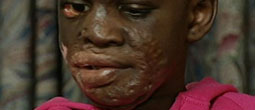dangers of kerosene
Death and Sickness
2.5 million people die annually from the use of kerosene in their homes.
One every 12 seconds.
Deaths from respiratory illness, burns and aspiration are the most common. Most of these are children. The primary cause of death is from respiratory failure, particularly in young children. Like mothers everywhere, these mothers want to keep a dim light burning in order to keep an eye on their babies at night.
What they do not realize is that the toxic fumes from the lamps that are generated in these small enclosed spaces are poisoning their children. The largest percent of children who die from respiratory failure are under one year old. Respiratory illness is the number one cause of death in children under 5 years of age who live in underdeveloped areas.
Burn deaths are a major contributor to these numbers. Kerosene lamps are hot and unstable. They can explode, but most often turn over and ignite their surroundings.

In addition there are millions of non fatal but disfiguring burn injuries that leave their victims disabled and stigmatized.
Millions more suffer from non-fatal affects. Kerosene produces noxious fumes that can lead to a variety of ailments. Carbon monoxide replaces the oxygen indoors, which can result in lung and eye infections, respiratory problems, eye, nose, and throat infections, kidney and liver afflictions, and cancer.
If this is such a big problem, why don't you hear more about it?
You don't hear much about it because it does not happen here anymore, but it is still happening in small, remote villages all around the world. It was an everyday occurrence in the US, over a century ago.
Inadequate Lighting
According to the World Health Organization an average kerosene lamp provides 1/30th of the recommended amount of light for reading. The light is so poor that children can only see their books if they are almost directly over the flame. As a result, most have burn marks on their faces and they inhale even more of the toxic smoke.
There is no way for us to measure the amount of damage that dim light and toxic smoke is doing to the vision of these children. Besides being unhealthy, trying to do school work with a kerosene lamp creates a barrier to education and learning.
When kerosene lamps are replaced with solar powered LED lamps, children are not only safer, but able to study more effectively. One child remarked to us that "it was if I instantly became smarter". Because they do not have to strain to read the paper, students are able to complete their work faster and more accurately. Education becomes more obtainable.


